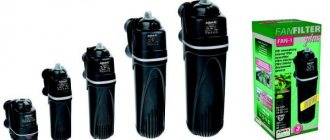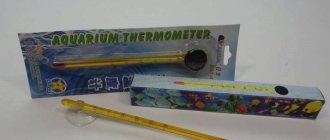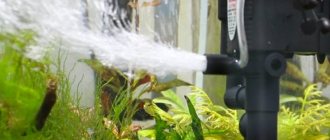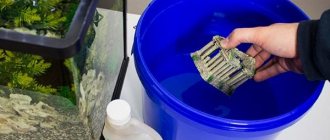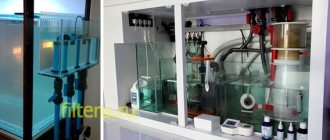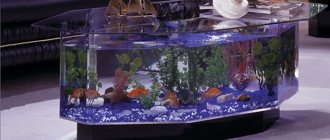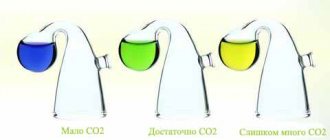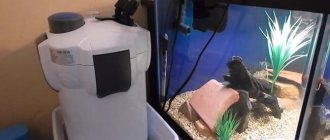Creating an extraordinary and well-functioning aquarium with colorful fish and lush plants is no easy task. Most often, beginner aquarists encounter difficulties when selecting equipment: in addition to lighting and filtration devices, they will need an aquarium pump - one of the most necessary devices in the aquarium hobby. Thanks to the operation of this device, the water is saturated with oxygen, and proper living conditions are created for representatives of flora and fauna. In order for the device to serve for a long time and work efficiently, you should know how to choose a pump for an aquarium.
Kinds
The choice depends on the size of the container. For small ones, a low-power one is suitable, for large ones - with higher performance.
Based on the installation method, the following types of devices are distinguished:
- internal;
- external;
- universal.
The external filter is installed outside the rear wall, the internal filter is installed inside. The universal device can be mounted as desired: inside or outside. The filter is attached using suction cups and clamps that are included in the kit.
Freshwater and saltwater aquariums also require different pumps. In freshwater tanks, a device with a metal axis is installed, and in sea tanks - with a ceramic one, since in salt water the metal quickly oxidizes and rusts.
Storm mode
Some pumps for creating current in a saltwater aquarium have a “Storm” function. Unlike equipment that merely simulates this natural phenomenon using LED flashes, advanced current pump models create conditions identical to those that occur on the reef during a storm. The pump increases the flow rate, creating a chaotic movement throughout the aquarium, lifting and mixing deuterium in those places where it accumulates. Upon reaching maximum power, uneaten food, dirt and detritus are thrown into the filter. Then, following the program, the pump reduces power and the storm ends.
Pump selection
An important parameter is where it will be placed and what size the aquarium itself is. External pumps are often chosen and installed on the back walls so as not to spoil the appearance. The ratio of throughput and power of the device is also important. The pump will be suitable for the aquarium if it pumps more than half of all the water in an hour.
It is important that the power of the device is selected correctly. If the power is selected incorrectly and the pump’s throughput is insufficient, it will not cope with its task. If the power is too high, the current will be too strong, which will interfere with the normal functioning of the fish.
Today you can find pumps for aquariums from different manufacturers. But how do you decide which pump to choose for your aquarium? It is important that the manufacturer is known in the market, and the price of the device is in the middle sector. A particularly important point when choosing is the noise level that the device will create.
How to use
In order to clean the bottom using a siphon, the extension of the tube must be placed in the ground, and its narrow end must be placed in a container of sufficient volume (a bucket, basin or large pan). After this, press the bulb several times (if it is missing, blow into the narrow end of the tube). Drain some of the water by moving the tube over the ground at such a height that only dirt is sucked into the siphon. Along with soil treatment, it is convenient to perform a partial water change.
If the siphon is equipped with protection against the suction of small stones, you can agitate the soil, immersing the funnel to the very base to improve the quality of soil cleaning. Immediately after cleaning, a fine suspension remains in the aquarium water. It does not pose a danger to fish, and after a few hours it settles to the bottom, after which the water becomes clear.
You can watch the video below for more details:
Useful tips
You should use the siphon with caution in aquariums with small bottom-dwelling organisms (snails, etc.) and delicate algae - there is a risk of injuring these living creatures. Areas densely planted with plants do not need to be treated with a siphon - a small amount of sludge at the bottom of the aquarium will not harm anyone.
Don't overfeed your fish
This will allow you to less frequently resort to cleaning the aquarium from food residues, which, when rotting, release hydrogen sulfide (it can be recognized by the characteristic smell of rotten eggs emanating from the bubbles rising from the day). In addition, moderate feeding prevents obesity in pets. The first few weeks after transplanting fish into the aquarium, it is not recommended to clean the aquarium. If cleaning is difficult due to severe soil contamination or other reasons, it is recommended to transplant all the fish into a separate container before starting the procedure. It is necessary that there is a sufficiently thick layer of soil (6-8 cm) at the bottom of the aquarium. This is especially significant for owners of algae that take root in the soil. It is advisable that the height of the soil at the front wall of the aquarium is less than at the back: this makes the cleaning procedure more convenient. However, not every soil (for example, medium-sized sand) will remain on a slope.
Caring for the device
All maintenance of the device consists of washing it and changing the filter on time. To make it easier to care for, the filter must be turned off when feeding the fish. Thanks to this, foam sponges remain clean longer, so they need to be changed less often. After feeding the fish, it is advisable to turn on the pump again no earlier than an hour later.
The device differs from a compressor in many advantages, the main one of which is a significant reduction in noise when filtering water. There are a number of criteria that must be taken into account when choosing:
- container size;
- the purpose for which the pump will be used;
- if the part is installed to fill the aquarium with water, you should pay attention to the level of water rise;
- filter performance;
- aesthetic appearance.
It is better to choose more expensive models from trusted manufacturers that guarantee product quality.
How to choose the right one
When choosing a pump, several factors are taken into account.
Purposes of application
Decide what functions the pump will perform. Attach a sponge for mechanical filtration. The device is used as a main filter or as an additional purifier. Together with a tube located above the surface of the water, the unit will serve as an aerator.
If a pump is purchased to fill an aquarium, the level of water rise is taken into account. To pump out, you will need a hose that extends to the place where the liquid will drain.
Aquarium volume
Productivity is calculated based on the volume of the vessel. It takes 3–5 times more liquid to pump per hour than in a home pond. Small aquariums use a pump with a capacity of up to 380 l/h. In medium-sized containers – up to 600 l/h. For volumes of 500 liters or more you will need a pump with a capacity of 5000–8000 l/h. The price for such equipment will be higher.
Excessive pressure is detrimental to the inhabitants of the aquarium.
Type of reservoir
Devices with metal components are suitable for a freshwater tank, and ceramic ones for salt water. There are also universal devices.
Tank location
Despite the relative quietness of pumps in operation, some models will be a source of noise. Outdoor pumps are louder, so keep this in mind when placing equipment in rest areas. The noise parameters can be found in the attached data sheet with instructions.
Popular models
Manufacturers have their pros and cons. Value for money, power regulation - distinguish one brand from another. Before purchasing, read product reviews and compare specifications.
Models from the following manufacturers are often found:
Eheim Pumps with universal arrangement. Attached to suction cups, suitable for salt and fresh water. Power is adjustable.
Resun More often on sale are inexpensive pumps for small and medium-sized aquariums. Minimum capacity 200 l/h.
Hailea Aquarium pumps are equipped with a suction cup and power adjustment. Models for tanks of different sizes.
Aquael Devices with a minimum output of 350 l/h. For medium and small containers.
Aquarium system Reliable devices with overheating protection, well proven. There is an adjustment of the water flow and power range.
Tunze Universal pumps with different capacities. Compact and silent.
Device functions
Regardless of which pump manufacturer, size and power the client chooses, it must perform certain functions:
- Create a flow of water masses inside the aquarium, since without this the fish cannot exist. In an aquarium where there are corals, there is no way to do without such a pump, since only through the flow do the corals receive the necessary nutrients.
- Circulate the water. Thanks to circulation, the water is purified and filled with oxygen. The pump also mixes purified water with the remaining water, which retains the microclimate created by fish and corals.
- Help the operation of filters and other devices installed in the aquarium. Therefore, it is important to install the pump so that water from the aquarium does not fall on its body.
If the selected pump in the aquarium meets these parameters and does not cause any malfunctions, then it is suitable for a certain aquarium.
Details
Each compressor is designed for a specific volume of liquid
...and the water column, and therefore this indicator is the main one when selecting the power indicator of the device. To calculate the required level of aerator performance, you need to multiply the volume of water by 1/2. We suggest considering the types of aquarium professional compressors:
- Piston ones are considered the most powerful, and are also used for large aquariums with a huge volume of water (more than 200 liters). The downside of such units is the incredibly loud noise and loud operating sounds that appear as a result of the movement of the piston-type mechanism.
- Diaphragm - such air pumps operate in a quiet mode, but are not completely silent. They are able to function due to the movement of a rubber membrane, which pumps oxygen into the outlet plastic pipe.
Such specialized devices can be found in all animal stores, and they also operate using an electronic motor, and the price ranges from 200 to 20,000 rubles (depending on the manufacturer, size and power level). But, if you have the opportunity and desire, it is best to create a device with your own hands from available materials using very simple technology. Let's look at the features of a homemade compressor:
Quiet operation - the unit was assembled with your own hands, and also functions without buzzing and sharp sounds, like, for example, piston or membrane models. For this reason, it can even be placed in the bedroom without fear of noise. No electrical power required - the device does not depend on electrical energy in any way. Long service life - due to the absence of electromechanical components, the durability of this equipment can be noted
It is only important to remember that once every couple of months you will need to lubricate the pump.
A homemade compressor for an aquarium will be much easier
Components of a do-it-yourself aerator:
- Main body (in order to attach all the constituent elements).
- Rubber tube (responsible for atomizing air).
- Pump (heats and will pump oxygen into the aquarium space).
- Electric motor (low speed).
- Machs with an eccentric (it will be responsible for converting rotational movements at the shaft into translational ones).
Next, let's move directly to the assembly process.
Assembling a miniature compressor from a plastic cover
Let's take a closer look at the assembly stage:
First, you need to remove the entire seal from the lid, and then use a marker to mark future holes for the plastic tube, which are made with sharp scissors. From a piece of rubber you need to cut out a small piece in the shape of a horseshoe, and after that it needs to be tightly glued to the inside of the lid, which has been previously coated with adhesive. Now you can begin drum assembly - structures that provide air pumping. To do this, a piece of the balloon must be placed on the lid and secured with tape. Next, take a plastic card and cut out a circle in it with a smaller circumference than the plastic lid itself. A lollipop stick needs to be glued to one side of the circle, and the second part can be attached to a miniature balloon drum using hot glue. After this, you need to cut off a small part of the glue for the gun, and use an awl to make a couple of holes - at the central point, as well as at the edge. Fix the motor in the center and the wire on the side. Attach the motor to the wood base, and after that you need to apply the position of the second element
It is important to cut off the excess and connect the device into one whole. The final step is to attach the motor to the tube, and now you have a homemade compressor for your aquarium!
To do this, it is not at all necessary to buy expensive membrane or piston units in pet stores, but you can also assemble a special device with your own hands, using inexpensive materials and fairly simple technologies. Below in the video, which is a visual master class, you can learn how to make a silent compressor yourself from simple materials.
Water pump
For owners of aquariums with a large volume of water, changing it becomes a frequent problem. Since it is impossible to lift such a container, the water has to be pumped out in parts and carried out in buckets. This is very long and inconvenient. To speed up this process, a special aquarium pump is used to pump out water. For this purpose, a special hose is selected, which is pulled into the toilet room. The device is used to suck the air out of this hose. One end of the hose is attached to the device, and the other ends into the toilet or sink.
How does a submersible pump work?
The device consists of a motor and a filter. Powered by electrical power.
The sealed housing includes the following components:
- A motor that consists of a stator and a rotor with an impeller.
- The filter compartment has a cylindrical shape with perforations. It serves as the basis for a multilayer filter, which purifies the suction water from solid particles. The pump filter is a multi-layer sponge
Principle of operation:
When the engine is running, the rotor with the impeller supplies aquarium water to the filter for purification. The filtered moisture flows back into the container through the outlet pipe. Modern models are equipped with an aerator that saturates the water with oxygen.
Popular manufacturers
The models differ from each other only in performance and power. But you should not save on such a necessary device, since the cheap option often turns out to be of poor quality.
The most popular models:
- Aquael - developed in Polish factories. Average power and performance. The engines are only energy-saving. The seals are made of high quality materials, therefore the degree of loss of efficiency is significantly reduced. Often used as circulation pumps.
- Juwel Eccoflow is a German development with average performance. There are power regulators and automatic impeller cleaning.
- Aqua Medic is a high power pump. Used more often in salt water aquariums. The device is capable of simulating surf. The magnetic motor significantly reduces vibration torque.
- Deltec – automatic universal devices. The pump can work properly in any liquid medium, dose and supply fertilizers, and water plants. The pumps are powerful and have a controller.
- Tunze – designed for any type of aquarium. Energy consumption is low. The products have excellent design. The pumps are durable and are attached using a powerful magnetic holder. There is a wave generator function that ensures uninterrupted water circulation and heat distribution.
You can choose any pump for your aquarium. It is important to know why it is needed and what features this or that model has. Having studied all this, you can make the aquarium an excellent habitat for the most exotic fish.
What are there
In real reservoirs, oxygen is supplied by wind flow and water vibrations.
In a closed container, aquarium pumps are responsible for this process. The pumps differ:
- By design. There are piston and diaphragm options.
- By installation. There are submersible and external.
Piston devices will last a long time, and they are more powerful than membrane ones. Their disadvantage is that they make a lot of noise and vibrate. Such devices should be used for aquariums with a volume larger than 200 liters. Diaphragm pumps operate silently and consume minimal energy. They have one drawback - they are suitable for containers up to 150 liters.
Purpose and principle of operation
Animals in an artificial reservoir need a sufficient amount of oxygen. Poor aeration causes the water to quickly become cloudy. This has a detrimental effect on the health and vital activity of the living inhabitants of the container. And the tank begins to look unsightly. Gradually the aquarium turns into a small swamp.
Pumps pumping water are necessary in order to avoid all these unpleasant consequences. They perform the following functions:
- Keeping the tank clean.
- Saturation of aquarium water with oxygen.
- Creating circulation.
Air supply for aquarium animals and plants must be provided constantly, especially at night. This is due to the fact that during the daytime oxygen is released under the influence of light, and at night the process stops. As a result, the reservoir becomes oversaturated with carbon dioxide. Thanks to the pump, oxygen constantly enters the container. You can purchase a filter pump in the form of a foam rubber sponge. In this case, the speed of water purification occurs faster.
A pump should also be purchased in the following cases:
- Reservoir overpopulation.
- Non-standard container shape. The pump must be used in a tank that is too narrow or deep.
- There are no living plants in the artificial pond. The device is also needed in case of too much vegetation.
- If water biofiltration is impaired.
- The container with fish is closed with a lid without holes.
An aquarium pump prevents the appearance of greasy deposits in the upper layers of water. The device mixes the liquid, equalizing the temperature in the tank. The pump is also a decorative element. The resulting bubbles fall in a cascade, simulating a fountain or waterfall.
Peculiarities
Some aquarists choose aquarium pumps. Widespread use is due to the following advantages:
- silent operation;
- multifunctionality;
- portable design;
- design.
A water pump is something you cannot do without; it is needed for important parameters:
- aeration;
- filtration;
- movements inside the reservoir;
- streams and waterfalls;
- filling the vessel;
- pumping out water.
Bandwidth
A homemade or factory-made pump for an aquarium must have the necessary throughput. Using this parameter, the water flow necessary to meet the physiological needs of living organisms is created. In simple words, the calculated pumping value of 100 liters of capacity is ensured by a pumping capacity of 300-500 l/h.
According to the established rules, the pump capacity must correspond to pumping five volumes of the reservoir used. According to calculations, the pump should pump 3-5 such aquariums per hour of operation. Proper circulation not only cleans the aquatic environment, but also transfers oxygen there, maintaining a comfortable microclimate for fish and other inhabitants.
Purpose of pumps for aquariums
An aquarium pump is an essential part of aquarium equipment. It is responsible for the “life activity” of the reservoir, the purity of the water and its saturation with oxygen. In natural habitats, nature provided the fish with oxygen due to wind blowing and water fluctuations. Since such natural phenomena are not inherent in an artificially created reservoir, you have to solve this issue yourself.
Therefore, an aquarium pump is vital. The compressor creates pressure and supplies air directly to the liquid. This process of air ventilation is called aeration. For such a set of measures, filters are used, most often an air pump (microcompressor). It pumps oxygen into the water through a tube and a nebulizer, a porous tip that turns a stream of air into small bubbles.
It is important that the unit you choose is able to satisfy the air needs of the small inhabitants of the aquarium. Air exchange in a small tank will be provided by a small inexpensive pump for transferring
To service an entire “economy” you will need a powerful and large model. Some devices even allow you to service several aquariums. It is recommended to purchase an air one, even if there is no urgent need for it.
In the aquarium, aeration should be carried out around the clock to ensure a stable gas exchange regime. Fish especially need to saturate the water with oxygen at night, since photosynthesis occurs only in daylight, and at night there comes a time when there is a lack of air and an excess of carbon dioxide.
Circulation pump for aquarium
The importance of pumps for fish and water is undeniable. By mixing the upper and lower layers of water, they are also needed to equalize the temperature of the liquid and prevent sudden changes. Rising temperatures have an extremely negative impact on fish. Thanks to the work of compressors and the aeration they create, the greasy, unpleasant film that interferes with gas exchange is destroyed.
In addition, certain environmental conditions necessary for some types of aquarium fish are simulated. Compressors help increase soil flow, providing soil bacteria with the conditions required for normal life. This, in turn, prevents the decay of organic residues and the appearance of hydrogen sulfide, methane and ammonia, which are also harmful to fish.
Why is aeration needed?
Fish and shellfish, during the process of respiration, and in the absence of light, algae, absorb oxygen dissolved in water, exhaling carbon dioxide. There is a lack of oxygen - an unfavorable environment for the inhabitants of the aquarium is formed. Pets begin to choke, may get sick, or die. Additional benefits of aeration come from mixing the layers of water:
- The sediment rises from the bottom, which makes the filters more efficient.
- The temperature is evenly distributed during the operation of water heaters and cooling devices.
- The proliferation of harmful bacteria, algae, protozoa, and parasites living in stagnant water is prevented.
- Aeration is necessary for most fish species, except those that prefer low oxygen levels in the water.
- Allows you to keep more individuals without the need to increase the capacity of the aquarium.
The aquarium aerator should be used constantly.
Top best
Among all the diversity of the market, it is worth highlighting popular models that have surpassed competitors in terms of criteria. This will make it much easier to choose a device for your home aquarium.
jbl prosilent a300
Diaphragm compressor made in Germany. External installation method. Powerful, has high productivity, more than 300 liters per hour. Suitable for aquariums with a volume of 100 liters or more, and provides a stable supply of oxygen in 400-500 liter tanks.
It has two air duct tubes, which improve the aeration of large containers and increase the decorative appearance of the aqua. Almost silent, produces sound up to 38.5 dB, which is comparable to a quiet whisper. For this kind of performance, this setting is ideal.
Its disadvantage is that it is overpriced, but for large capacities it will be optimal in terms of performance to price segment.
tetra ars 300
Some batches of these compressors are produced in China, others in Poland. The gadget has an expressive design and will not spoil the interior when connected. You need to make sure that the aerator is above the water level, otherwise when you turn it off, water will get into the motor. There is a filter and air supply adjustment. There are several different devices in this series in terms of performance. The device is reliable and can operate for many years without reducing productivity.
eheim air pump 200
Another German representative, but with assembly in China. 3 year warranty, power regulators included. Suitable for aquariums 350-300 liters. The compressor is two-channel, can provide oxygen to two aquariums at once, it is equipped with two outlets. It will be good for those who are engaged in breeding and place young animals or fish for spawning in a separate jar. There is a Velcro mount for the wall, which makes use comfortable, safe and invisible in the interior. Can work in salt and fresh water.
hydor ario 4
An Italian brand that has proven itself among aquarists. These are submersible compressors that do not require separate space or additional care. The device is installed on the bottom using special fasteners. Can be decorated as an underwater object. The only negative is that there must be a minimum distance of 50 cm from the bottom to the surface. Due to its location in the water, vibrations are absorbed, so the noise level is minimal. Capacity 200 l/h, there is an air regulator.
schego optimal
Compact compressor of German origin. Despite its small dimensions, it has a capacity of 250 l/h and provides aeration in containers up to 600 liters. In this case, the electricity consumption is 5 W.
It produces a two-meter column of bubbles, which is enough to supply oxygen to several aquariums. Almost silent, has a regulator, can be installed horizontally and vertically.
Safety precautions
To prevent injury when operating the device, follow safety precautions. Before using the device, you should study the safety instructions compiled by the manufacturer. The danger of using the device is that it operates in water and improper use may result in electric shock. Mandatory rules include the following:
- If water gets on the electrical components or they become wet, you need to disconnect the device from the power source and thoroughly wipe and dry.
- Do not turn on the pump if the cable is damaged, it is not working properly, or there are other problems.
- It is necessary to turn off the device before cleaning, disassembling, or starting.
- The pump must not be allowed to run dry.
In any case, it is better not to try, if problems arise in the operation of electrical equipment, troubleshoot the problem yourself, you must contact the service department.
